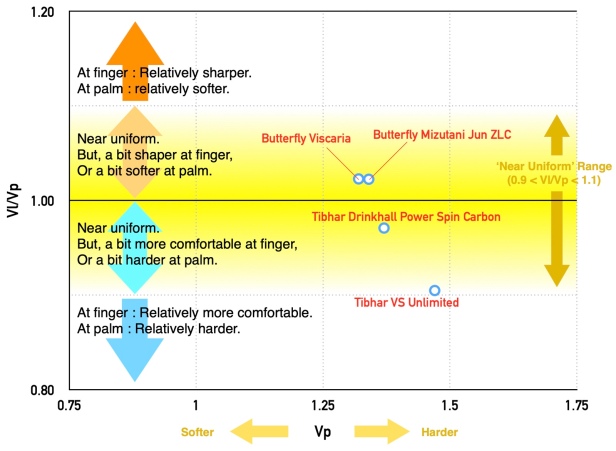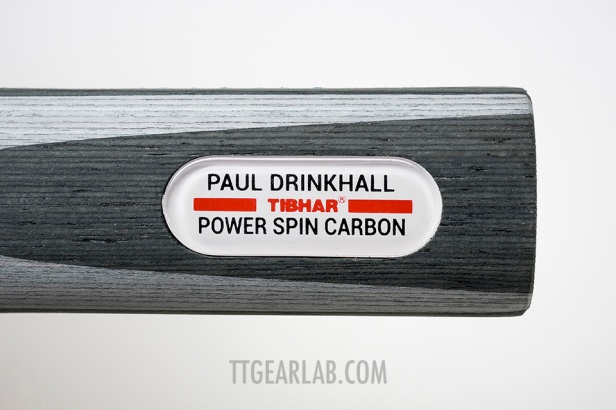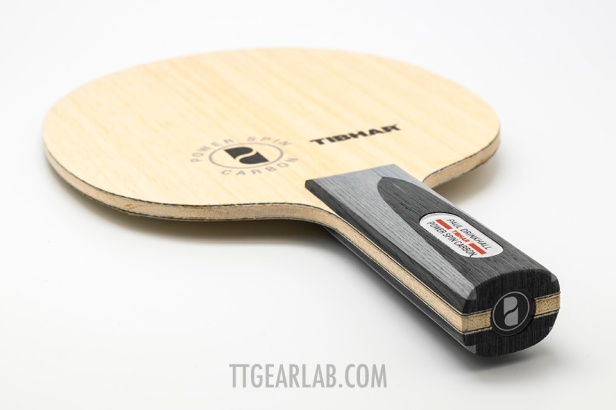1. Introduction – Drinkhall Power Spin Carbon
[Note : Because the measured pcs. of ‘Timo Boll ALC’ seems to be too much biased to harder/faster side, it has been replaced with ‘Viscaria’. TTGearLab will measure the recent version ‘Timo Boll ALC’ sooner and later and update the data of ‘Timo Boll ALC’.]

Tibhar ‘Drinkhall Power Spin Carbon’ is the signature blade for Paul Drinkhall. And, at the same time with ‘VS Unlimited’, it is one of recent top models of Tibhar blade range.
Concerning ‘Drinkhall Power Spin Carbon’, Tibar is explaining as follows:
Paul’s signature blade and no problem here with blade build! Paul’s requirements are specific – a blade providing balance and power both at the table and at mid distance for his aggressive spin game played on forehand and backhand wings. The blade needed to be exceptionally stable to ensure tremendous control and touch when playing a short game, despite the requirement for high speed characteristics.
After months of trials TIBHAR have finalized Paul’s new weapon the POWER SPIN CARBON. The blend of high quality arylate carbon with 5 wood plys creates a fantastic sweet spot and elastic feel that helps enable him to maintain the upper hand in fast counter spin rallies.
The Power Spin Carbon blade provides a seamless interface between you and your equipment, ideal for the offensive player who demands speed and spin with control, to ensure exact and precise placement at all times.
Regarding plywood construction, Tibhar tends to apply very unique construction on blades. But, ‘Drinkhall Power Spin Carbon’ is an exception. The plywood of ‘Drinkhall Power Spin Carbon’ is based on common construction that is seen from many existing blades in the market.

The plywood of ‘Drinkhall Power Spin Carbon’ is based on 5-ply wood construction. And, ‘Arylate Carbon’ is placed directly under top layer. The wood of top layer is Koto. Overall thickness is about 5.7mm.
Inserting fiber directly under the top layer of 5-ply wood construction is a very orthodox way of making the construction of fiber blade. This is called as ‘outer fiber construction’. When compared with ‘inner fiber construction’ whose fiber is placed under second or third layer, ‘outer fiber construction’ can utilize the performance of fiber more efficiently. But, the shortcoming of ‘outer fiber construction’ is artificial feeling that is noticeably different from the feeling of pure wood blade.
‘Outer fiber’ blades whose thickness is 5.5~6.0mm has become the standard weapon of top players after the introduction of poly ball. Currently many top players are using ‘outer fiber’ blades.
‘Drinkhall Power Spin Carbon’ can be compared with some other ‘outer fiber’ blades. I selected three models for comparison.
- Butterfly Viscaria
- Tibhar VS Unlimited : Thicker. Different top layer.
- Butterfly Mizutani Jun ZLC : Different fiber. Different top layer.
Among three blades, ‘Viscaria’ has very similar construction as ‘Drinkhall Power Spin Carbon’. However, there are many cases that similar construction doesn’t mean similar characteristics. We have already seen that case from former posting – “Tibhar VS Unlimited vs. Butterfly Freitas ALC – Comparison“. The difference between the philosophy of one maker and that of another maker results in the difference of characteristics of blades with similar construction. ‘Performance Indices’ will provide us good guideline for understanding the difference between one blade and another blade.
Concerning the detail of four performance indices, please refer to following articles in ‘Background’ section :
- Performance indices : the way to evaluate blade by measurement
- The example of comparison by performance indices
2. Comparison by Performance Indices
First, ‘Elasticity Indices’ of seven blades will be examined. Fig.03 shows the comparison graph of ‘Elasticity Indices’.

Ep (Primary Elasticity Index) is directly concerned with the rebound speed of blade. Primary Elasticity Indices of four ‘outer fiber’ blades are close to 2.0. Ep of ‘Drinkhall Power Spin Carbon’ is 1.93. Ep of ‘Timo Boll ALC’ whose construction is similar to that of ‘Drinkhall Power Spin Carbon’ is 2.02. From this result, we can expect that ‘Drinkhall Power Spin Carbon’ is a little bit slower than ‘Viscaria’.
On the contrary, Ec (Central Elasticity Index) of ‘Drinkhall Power Spin Carbon’ is higher than that of ‘Viscaria’.
Ec is concerned with additional ‘kick’ when player hits ball very hard. So we can expect that ‘Drinkhall Power Spin Carbon’ will provide more kick than ‘Viscaria’ when we hit ball very strongly, although the primary elasticity of ‘Drinkhall Power Spin Carbon’ is lower than that of ‘Viscaria’.
Tibhar ‘VS Unlimited’ shows higher elasticity with the same tendency as ‘Drinkhall Power Spin Carbon’. The Ep of Butterfly ‘Mizutani Jun ZLC’ is a bit higher than that of ‘Timo Boll ALC’. But, its Ec is same as that”Drinkhall Power Spin Carbon’.
We can noice that ‘Drinkhall Power Spin Carbon’ shows noticeably different behavior from ‘Timo Boll Spirit’.
Examining Ec/Ep is an easier way to understand the tendency of elasticity of blades. Fig.04 shows the relationship between Ec/Ep and Ep.

Ec/Ep expresses the ‘tendency’ of the elasticity of blade. By examining Ec/Ep and Ep at the same time, we can easily understand the behavior of blades.
The alignment of four blades on the graph looks close to a vertical line. Two Tibhar blades are categorized as ‘Mild Kick’. And, two Butterfly blades are categorized as ‘Deep Hold’. The blade that kicks ball most strongly when we hit ball very hard is ‘VS Unlimited’ among four blades. And, the blade that holds ball most deeply when we hit ball very hard is ‘Mizutani Jun ZLC’.
Ec/Ep of ‘Drinkhall Power Spin Carbon’ is close to 1.00. Its reaction on the change of impact force is almost linear. Thanks to the almost linear reaction, we can easily expect the result of impact input. And, it makes all-round play very easy. On the contrary, ‘Mizutani Jun ZLC’ those hug the ball deeply when we hit the ball very strongly fits better for very aggressive topspin at close-to-table area. ‘VS Unlimited’ whose Ec/Ep is the highest among the blades under comparison is suitable for power-oriented play.
In fact, all four blades under this comparison are suitable various strategies of modern offensive play. However, comparison by Elasticity Indices will help player when ‘fine tune’ of blade is required for the selection of the best weapon that fits for his/her personal characteristics.
Then successively, let’s compare Vibration Indices. Fig.06 shows the comparison graph of Vibration Indices.

Vibration Indices are concerned with feeling. Vp indicates primary feeling which is transferred to player’s palm. And, Vl is the feeling at the wing of a blade. It is felt by player’s inderx finger or middle finger.
The Vp of ‘Drinkhall Power Spin Carbon’ is 1.37. It is the second highest value among the Primary Vibration Indices of four blades under comparison. ‘Viscaria’ whose Vp is 1.32 is a bit softer than ‘Drinkhall Power Spin Carbon’. However, we can see different result in Vl. The Vl of ‘Viscaria’ is 1.35, and is higher than that of ‘Drinkhall Power Spin Carbon (= 1.33). As a result, the overall feeling of ‘Drinkhall Power Spin Carbon’ is much different from that of ‘Viscaria’.
The feeling of ‘Drinkhall Power Spin Carbon’ is relatively harder at palm and relatively sharper at fingertip of index finger. On the contrary, the feeling of ‘Viscaria’ is relatively softer at palm and relatively harder at fingertip of index finger. Both of those two can be considered as the blades with near uniform distribution of feeling because the gaps between Vp’s and Vl’s are very small.
The hardest among four blades is ‘VS Unlimited’ whose Vp is 1.47. But, its Vl is same as that of ‘Drinkhall Power Spin Carbon’. It means that the feeling of ‘VS Unlimited’ at the fingertip of index finger is similar to that of ‘Drinkhall Power Spin Carbon’.
The feeling of ‘Mizutani Jun ZLC’ can also be considered as uniform, and is close to that of ‘Viscaria’.
Examining Vl/Vp is an easier way for the comparison of the tendency of feeling. Fig.07 shows the relationship between Vl/Vp and Vp for easier comparison.

Again, four blades under comparison are aligned close to a linear line on the graph.
Vl/Vp of ‘Drinkhall Power Spin Carbon’ is close to 1.0. It means that the feeling of ‘Drinkhall Power Spin Carbon’ is almost uniform. However, ‘Viscaria’ and ‘Mizutani Jun ZLC’ are in the category that the feeling at fingertip of index finger is relatively sharper or the feeling at palm is relatively softer. It can be clearly noticed by player who is using ‘Viscaria’. In many cases, players feel that ‘Viscaria’ provides somewhat sharp feeling at the fingertip of index finger compared to basic feeling at palm. Sensitive players will feel that ‘Drinkhall Power Spin Carbon’ is not similar to ‘Viscaria’. The players who mostly feel the feeling at fingertip will tell that ‘Drinkhall Power Spin Carbon’ is milder than ‘Viscaria’. But, the players who mostly feel the feeling at palm will tell that ‘Drinkhall Power Spin Carbon’ is harder than ‘Viscaria’. Also, there will be some players who feel that there isn’t much difference between ‘Drinkhall Power Spin Carbon’ and ‘Viscaria’.
Although there is little difference, ‘Mizutani Jun ZLC’ is very close to ‘Viscaria’ on the graph. And, we can observe that ‘VS Unlimited’ is the blade with the most comfortable feeling at the fingertip of index finger.

3. Summary

Tibhar ‘Drinkhall Power Spin Carbon’ is the signature blade for Paul Drinkhall. Its construction looks similar to that of Butterfly ‘Viscaria’. However, the mechanical characteristic of ‘Drinkhall Power Spin Carbon’ is somewhat different from that of ‘Viscaria’.
‘Drinkhall Power Spin Carbon’ gives more kick than ‘Viscaria’ when the player hits the ball very strongly. And, ‘Drinkhall Power Spin Carbon’ lies very close to the border between ‘Hold’ range and ‘Kick’ range, it is expected that the response of ‘Drinkhall Power Spin Carbon’ on the strength of impact is almost linear. It means that the player can always easily predict the rebound output relative to the impact input.
Regarding feeling, the feeling of ‘Drinkhall Power Spin Carbon’ is relatively more comfortable at fingertip of index finger and relatively harder at palm., while the feeling of ‘Viscaria’ is relatively sharper at fingertip of index finger and relatively softer at palm. But, the distribution of feeling can be considered to be almost linear.
Although all four blades compared in this posting are suitable for various playing styles of modern offensive play, it is expected that Tibhar ‘Drinkhall Power Spin Carbon’ fits a bit for modern all-round style, while ‘Viscaria’ fits a bit more for aggressive style, and ‘VS Unlimited’ is more suitable for power-oriented style. And, ‘Mizutani Jun ZLC’ fits for more aggressive playing style. But, because those two are also close to ‘Uniform’ line, it is expected that ‘Viscaria’ and ‘Mizutani Jun ZLC’ also fit for modern all-round style.


Wow I just found your site and your reviews are amazing! I really enjoy all the unique information you provide. Keep up the good work
LikeLiked by 1 person
Thank you. I will try to post more reviews.
LikeLiked by 1 person
is it available in penhold?
LikeLike
Unfortunately it is available only in shakehand. However, in China we can find many penholder models of Tibhar blades those are not officially available in penholder. So maybe it is in China. But, if you can’t read and write Chinese language, ordering it will be difficult.
LikeLike
In terms of speed which is faster? tibhar paul drinkhall powerspin carbon or butterfly timo boll alc??
LikeLike
In fact, speed is more concerned with covering (rubber) than blade. That is because we barely make a shot without spin. But, if we only consider direct hit without spin, Timo Boll Spirit is faster if we hit ball softly, and Drinkhall Power Spin Carbon is faster if we hit ball with full power.
LikeLike
(I wrote as Timo Boll Spirit. But, it means Timo Boll ALC. In fact those two are identical to each other except for graphic design.)
LikeLike
I like the handle shape of Butterfly ALC ST or Spirit ST. The handle is around 27,8 mm wide and 22,5 mm thick. What are the exact handle dimensions of the new Tibhar Powerspin Carbon blade in thickness and broadness ?
LikeLike
When compared to the handle of Timo Boll ALC/Spirit ST, the handle of Drinkhall Power Spin Carbon ST is quite thick and wide. Its thickness is around 23,1mm, and its width is around 29.0mm.
Because the edge of the handle of Drinkhall Power Spin Carbon ST is rounded, the actual difference of grip feel is compensated a bit. But, still you will feel that the handle of Drinkhall Power Spin Carbon ST is noticeably thicker and wider than that of Timo Boll ALC/Spirit ST.
If you like the handle of Timo Boll ALC/Spirit ST, you may feel uncomfortable with the handle of Drinkhall Power Spin Carbon ST, and probably there will be trouble in using wrist. However, if you have suffered from the unstable grip feel due to insufficient width or thickness of the handle of Timo Boll ALC/Spirit ST, you will be happy with Drinkhall Power Spin Carbon ST.
LikeLike
This is a relatively silly question but which blade reverses spin better vs unlimited or drinkhall power spin. Are their handles the same ??
LikeLike
It depends on the ability of player. If the level of a player is not high, slower blade is recommended for the ability of reserving spin. But, if the level of player is high, there is bigger freedom of the selection of blade.
LikeLike
What is the balance like in both the vs unlimited and drinkhall power spin blades?
LikeLike
Excellent analysis and some interesting insight in the world of Tibhar !
Can you please do the similar test for Nittaku barwell fleet ?
Thank you
LikeLike
Thank you for comment. Currently I don’t have Barwell Fleet. If I can get a piece I will also test it.
LikeLike
Great article! May i correct your thickness measurement of Drinkhall PSC. It’s actually 6.2 mm thick as seen measured on TableTennisDaily. Perhaps that explains the extra stiffness when compared to Boll ALC. mabye you could chuck Viscaria and Stradivarius into the mix next time when you decide to review carbon blades 🙂
LikeLike
Thank you for comment! But, the thickness of Drinkhall Power Spin Carbon doesn’t exceed 6.0mm. I think that the value on TableTennisDaily is wrong. I have just measured one pc. of Drinkhall Power Spin Carbon. Its thickness is just 5.6mm.
The construction of Drinkhall Power Spin Carbon can’t exceed 6mm because its top layer is very thin.
LikeLike
Why does a blade with same composition and same thickness as Timo Boll ALC perform so differently?
The only variables left that i can think of are ;
1)Wood grain direction
2)glue used
More likely number 1, Any thoughts?
LikeLiked by 1 person
I think both contributing 50-50. E.g. Nittaku Acoustic is very unique because of the processing steps and special glue used to combine layers.
LikeLike
Hi TTgear Lab,
It is really interesting to see your amazing review of this blade! I really like how Paul Drinkhall performance during T2Apac and which attract me to search for this blade Tibhar Drinkhall Carbon Spin. I am currently using Timo Boll ALC ST handle with MXP rubbers both side and really like the feeling but one thing i dislike about Timo Boll ALC ST is the square handle which does not feel comfortable to me without any grip tape.
I am wondering how this Drinkhall carbon spin play compare to Timo Boll ALC and whether you feel the ST round handle feel comfortable to hold? Does these blade ST handle same as VS unlimited ST?
Hope to hear from you soon. Thank you.
LikeLike
Thank you for comment! If you concentrate on spin, the difference between Timo Boll ALC and Drinkhall Power Spin Carbon will not that big. However, if you frequently use direct hit, the difference may be quite big. Regarding ST handle, I prefer the ST handle of Drinkhall Power Spin Carbon. In fact, the ST of Timo Boll ALC is for children and the players whose hand is small. That is originally the handle of Butterfly Power Drive ST. Timo Boll originally used Viscaria. But, because he was too young his hand was small. Therefore he combined the small(That was because the plywood of Power Drive was thicker than that of Viscaria) ST handle of Power Drive ST to his Viscaria. Afterward Butterfly brought that model into production, and Timo Boll Spirit was launched. Further afterwards, Butterfly modified the graphic design of Timo Boll Spirit. That was the born of Timo Boll ALC. So the ST handle of Timo Boll ALC is the ST handle of old Power Drive ST.
And, ST handle of VS Unlimited is similar to that of Drinkhall Power Spin Carbon. But, VS Unlimited ST is a bit wider.
LikeLike
Can you compare with donic original true carbon? Thx
LikeLike